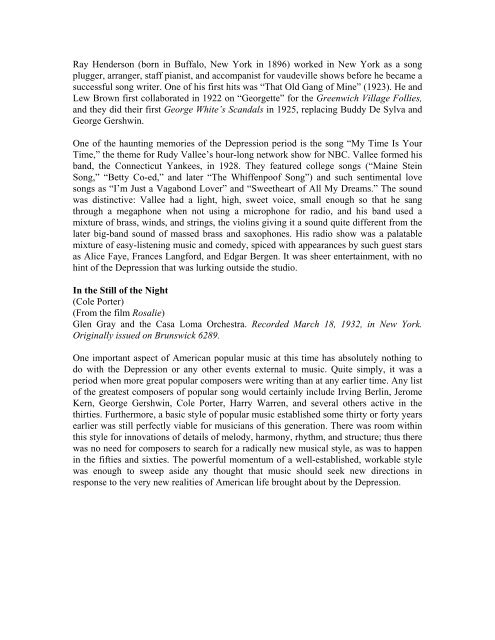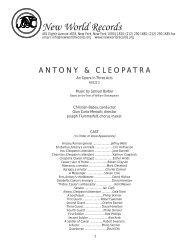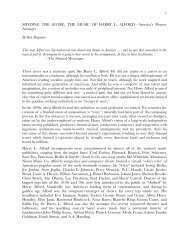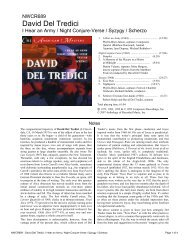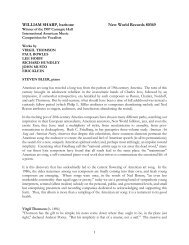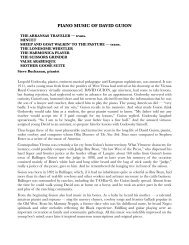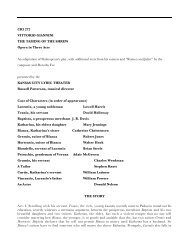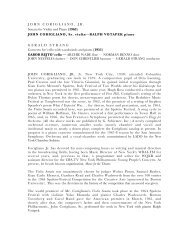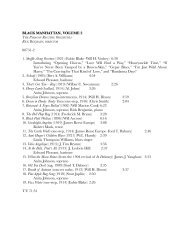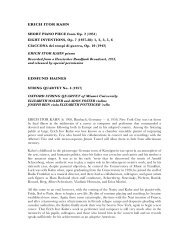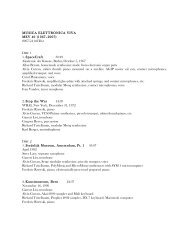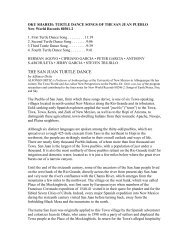Brother, Can You Spare a Dime? - New World Records
Brother, Can You Spare a Dime? - New World Records
Brother, Can You Spare a Dime? - New World Records
Create successful ePaper yourself
Turn your PDF publications into a flip-book with our unique Google optimized e-Paper software.
Ray Henderson (born in Buffalo, <strong>New</strong> York in 1896) worked in <strong>New</strong> York as a song<br />
plugger, arranger, staff pianist, and accompanist for vaudeville shows before he became a<br />
successful song writer. One of his first hits was “That Old Gang of Mine” (1923). He and<br />
Lew Brown first collaborated in 1922 on “Georgette” for the Greenwich Village Follies,<br />
and they did their first George White’s Scandals in 1925, replacing Buddy De Sylva and<br />
George Gershwin.<br />
One of the haunting memories of the Depression period is the song “My Time Is <strong>You</strong>r<br />
Time,” the theme for Rudy Vallee’s hour-long network show for NBC. Vallee formed his<br />
band, the Connecticut Yankees, in 1928. They featured college songs (“Maine Stein<br />
Song,” “Betty Co-ed,” and later “The Whiffenpoof Song”) and such sentimental love<br />
songs as “I’m Just a Vagabond Lover” and “Sweetheart of All My Dreams.” The sound<br />
was distinctive: Vallee had a light, high, sweet voice, small enough so that he sang<br />
through a megaphone when not using a microphone for radio, and his band used a<br />
mixture of brass, winds, and strings, the violins giving it a sound quite different from the<br />
later big-band sound of massed brass and saxophones. His radio show was a palatable<br />
mixture of easy-listening music and comedy, spiced with appearances by such guest stars<br />
as Alice Faye, Frances Langford, and Edgar Bergen. It was sheer entertainment, with no<br />
hint of the Depression that was lurking outside the studio.<br />
In the Still of the Night<br />
(Cole Porter)<br />
(From the film Rosalie)<br />
Glen Gray and the Casa Loma Orchestra. Recorded March 18, 1932, in <strong>New</strong> York.<br />
Originally issued on Brunswick 6289.<br />
One important aspect of American popular music at this time has absolutely nothing to<br />
do with the Depression or any other events external to music. Quite simply, it was a<br />
period when more great popular composers were writing than at any earlier time. Any list<br />
of the greatest composers of popular song would certainly include Irving Berlin, Jerome<br />
Kern, George Gershwin, Cole Porter, Harry Warren, and several others active in the<br />
thirties. Furthermore, a basic style of popular music established some thirty or forty years<br />
earlier was still perfectly viable for musicians of this generation. There was room within<br />
this style for innovations of details of melody, harmony, rhythm, and structure; thus there<br />
was no need for composers to search for a radically new musical style, as was to happen<br />
in the fifties and sixties. The powerful momentum of a well-established, workable style<br />
was enough to sweep aside any thought that music should seek new directions in<br />
response to the very new realities of American life brought about by the Depression.


